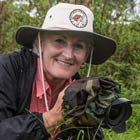
Galápagos Islands | Photography with Cindy Miller Hopkins and Sue Flood
Puembo
Apr 21, 2022
Upon arrival in Quito you will be met and escorted to your hotel. Dinner is on your own this evening.
Puembo
Apr 22, 2022
This morning enjoy a leisurely breakfast followed by program orientation. Depart for the city's central region to explore Quito, Ecuador's capital city and a historic UNESCO World Heritage Site. Learn about Quito's history from the pre-Hispanic times, through the Colonial Period, to the Republican Era. The architecture found in Quito's historical center is a great example of the Baroque style, which is a fusion of Spanish, Moorish, Flemish and Indigenous art. After lunch visit the Quito Botanical Gardens. The garden was created to conserve and exhibit the native flora of the Andes and has permanent exhibitions showcasing different ecosystems and plants from the high Andes, cloud forest, and dry forest habitats; the garden also displays a variety of ornamental plants. One of the main attractions of the garden is the orchid display, containing over 1,200 species of orchids. Return to the hotel for dinner this evening.
Puembo
Apr 23, 2022
After breakfast depart for Otavalo, located in the northern province of Imbabura. Upon arrival, venture on a cultural field trip to the Otavalo Market with an on-site discussion, "Otavaleños: Tradition and Globalization." The famed Otavalo Market dates back to pre-Inca times and to this day serves as a place where locals and visitors can buy or barter food, animals, basic necessities, and crafts. Otavaleños are well-known for their superior business skills, and examples of their craft can be found at this market and throughout stores in the country. Transfer to the small village of Peguche for a visit with an indigenous family, where you'll learn about their long-standing traditions in music, back-strap weaving, and herbal medicine. Head to a local restaurant for lunch and sample flavors of Andean cuisine, prepared with typical ingredients and products of the Ecuadorian highlands. Afterward, return to Quito, traveling through the scenic Imbabura Province.
Galapagos
Apr 24, 2022
After breakfast transfer to the airport for the flight to Baltra. Upon arrival in the Galápagos, transfer to the pier to board the Coral 2; receive an orientation and safety drill before setting sail. Afternoon Charles Darwin Research Station visit.
*Cruise itineraries are subject to change without prior notice for various factors including, but not limited to: safety, weather, mechanical breakdown, unforeseen emergencies, and the discretion of the Captain, Guide, and the Galapagos National Park.
Galapagos
Apr 25, 2022
This morning visit Dragon Hill on Santa Cruz Island. Arriving to a small lava dock, your first encounters are with marine iguanas that blend in perfectly to the dark rock. As you walk past large prickly pear cacti, arrive to one end of a long, sickle-shaped, beach with Dragon Hill standing in the distance. Your walk takes you on a circular path past a shallow lake, where flamingoes frequently come to feed. Waders such as stilts, turnstones and sandpipers work the muddy edges frenetically looking for food as you continue inland to a dry forested habitat, where land iguanas nest and burrow. After lunch visit Bartolomé Island, considered the most iconic landscape of the entire archipelago. The view from the top of Bartolomé Island, overlooking the famous Pinnacle Rock and the austere Santiago Island beyond, is well worth the climb up the wooden boardwalk. This volcanic scene has often been likened to a lunar landscape. Your subsequent snorkel here might put you face to face with Galápagos penguins, white-tipped reef sharks, and playful sea lions.
Galapagos
Apr 26, 2022
This morning make a wet landing at Rábida Island’s Buccaneer Cove. Dark red sand covers the unique beaches of this island and is home to multiple sea lion colonies. Rábida is considered the epicenter of the Galápagos Islands due to the diversity of its volcanic geology. Head out on a panga ride along marine cliffs to observe nesting seabirds, and then snorkel off the coast, where marine life is particularly active. Have lunch on the yacht, and then visit Espumilla Beach on Santiago Island an amazing location that features the remains of an eroded shoreline, which is home to seabirds, fur seals, and sea lions.
Galapagos
Apr 27, 2022
Today visit Black Turtle Cove, where you can find four species of mangrove in the extensive tidal lagoon system that stretches for almost a mile inland. During your panga ride through the labyrinth, spot many turtles, herons of several species, sharks, and rays. The experience is otherworldly and seems to transport you back to the beginning of time. This afternoon explore the central highlands of Santa Cruz Island, where you have the best opportunity to interact in close quarters with wild Galápagos giant tortoises. A short walk among these huge 600-lb reptiles will also offer the chance to spot more highland species, especially several species of the famed finches. A visit to the collapsed twin sinkholes (Los Gemelos) puts you in a stunning forest of the endemic tree-forming Scalesia. Apart from the dramatic scenery, this area is well known for its diversity of passerine bird species.
Galapagos
Apr 28, 2022
Punta Vicente Roca (Isabela Island) is surrounded by immense cliffs of the eroded volcano. Studded with resting seabirds including Brown Noddy and Nazca Booby, enjoy them in close proximity from your dinghies. Snorkeling here is superb, with certain species of fish only found in the west of the archipelago. You will also have a very real chance of swimming with penguins and potentially a plethora of green turtles. This afternoon visit the youngest island of in the Galápagos and one of the most pristine in the world. Fernandina Island is simply the marine iguana capital of the world. This desolate volcanic backdrop is home to a huge concentration of these enigmatic reptiles. Incongruously sharing the same shoreline, you can find the diminutive Galápagos penguins. Here you will also have the exciting opportunity to snorkel with marine iguanas feeding underwater, penguins, turtles, and the bizarre, endemic, flightless cormorants.
Galapagos
Apr 29, 2022
Today visit Urbina Bay (Isabela Island). At the far end of a long, level hike you arrive at a strange phenomenon, where large blocks of coral lie completely exposed after a dramatic geological uplift in 1954. Located at the western base of Alcedo Volcano you may run into a few very impressive land iguanas, as well as some of the volcano’s endemic Galápagos giant tortoises during the wet season. This afternoon visit Tagus Cove, a well-known hideout and deep-water anchorage in the days of pirates. Tagus Cove was also one of the few sites visited by Charles Darwin and the HMS Beagle in 1835. A beautiful hike leads you past an overview of Darwin Lake and on to a stunning volcanic landscape revealing Isabela Island’s dramatic northern volcanoes. Once back at sea level, the perfect activity is to snorkel along a submerged wall with turtles, penguins, a variety of fish, and potentially, flightless cormorants. You might even be tempted by a panga ride or kayak excursion!
Galapagos
Apr 30, 2022
On Santiago Island, Egas Port’s black volcanic sand sets it apart from most beaches. It is best known for the dramatic shoreline, where you will meet a host of species that chose to live between land and sea. Particular among these are the endemic Galápagos fur seals which maintain a small colony at the end of your walk. Other species of note include American Oystercatcher, sea lions, waders, herons, lava lizards, and even Galápagos Hawk. An optional visit takes you to an abandoned salt mine famous in its day for supplying salt to mainland Ecuador. After lunch explore Sullivan Bay. When viewed from the sea, the site does not look especially interesting, and visitors are always enthralled by the amazing beds of pahoehoe lava from the recent flow on the island. It is a landscape and macro photographer’s dream. The importance of pioneer plants such as the tiny Mollugo will be discussed as you hike over the lava. After your land visit you can enjoy a refreshing snorkel in the company of sea lions, turtles, and rays.
Guayaquil
May 1, 2022
This morning end your adventure with a visit to Bachas Beach, named for some wrecked World War II barges whose ribs are still visible in the sand. This visitor site offers great swimming, a lovely walk along the shore, and a visit to a lagoon behind the high tide line with wading birds, marine iguanas, and sometimes even flamingoes. The two beaches are also favorite nesting sites for green turtles, which often leave tractor-like tracks in the sand. Afterward, transfer to the Baltra Airport for your flight to Guayaquil. Time permitting, visit the Guayaquil malecón. Farewell dinner at the hotel this evening.
Farewell!
May 2, 2022
Transfers to airport after breakfast.

 Sue Flood
Sue Flood